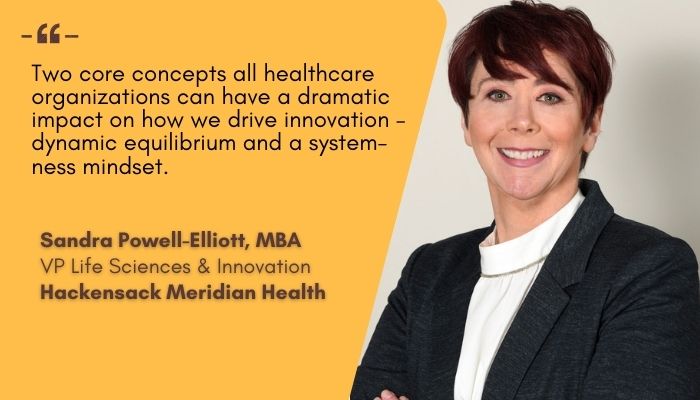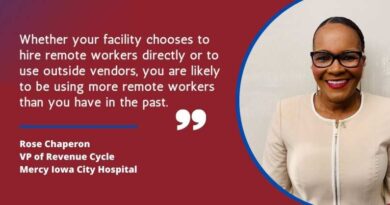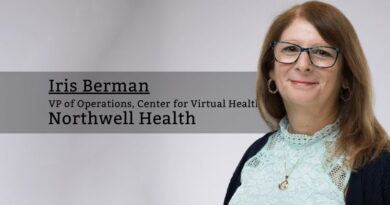A Pandemic’s Impact on Organizational Innovation
By Sandra Powell-Elliott, MBA, Vice President, Life Sciences and Innovation, Hackensack Meridian Health
Hackensack Meridian Health system is an integrated, not-for-profit health care network comprised of three large academic teaching hospitals, two children’s hospitals, 12 other hospitals across the state of New Jersey. HMH’s network includes 4,327 acute care beds, along with more than 500 patient care and physician locations, as well as a comprehensive home care and long-term care footprint serving more than 5.6 million people.
In March of 2020, the COVID-19 pandemic transcended on the communities we serve with great force. Luckily, the virus brought out the best in HMH’s clinical and research bench strength, providing both world-class care and testing innovation to our community during the surge and afterward. We always say that “innovation is in our DNA,” and the statement came to life as our more than 35,000 employees rose to the hourly challenge of scarcity of personal protective equipment, the need for more of almost everything including ventilators, pharmaceuticals, negative pressure rooms, and of course, testing supplies. Necessity indeed was the mother of invention and was this virus a “mother” indeed.
Developing an organizational culture focused on developing ideas, nurturing ideas to solutions, and acting to implement ideas was one of the keys to weathering unexpected challenges. However, there are lessons learned during the crisis which serve as a window into how any organization can further expand its efforts to embrace innovation during times of non-crisis.
First, the virus has taught us that small shifts in the world can suddenly shift the reality of all we experience. In the world of physics, it is referred to as “phase transitions” and a typical example, is the rapid change of water from liquid to solid as the temperature changes from 33 to 32 degrees and how traffic transitions from smooth sailing to a traffic jam. When speaking of innovation during the pandemic, one question that we all are finding ourselves ponder is, how do we keep the innovative ideas coming and the collaboration those ideas require for implementation? How can we manage to ensure that the flow of ideas and openness to innovation doesn’t tip back toward a solid brick wall of bureaucracy and resistance to change?
Sudden change is unpredictable like the emergence of a novel virus, but people and teams are creators of the predictable. Predictability comes from processes and structure whose goal is to de-risk decision making and demystify how work gets done. During our experience in managing the constant state of chaos called Covid-19, organizations began to function in an environment of great empowerment. Decisions were made at breakneck speeds, simply because the change in conditions were constant and the systems in place to care for patients were not able to meet the needs of clinician decision making and team member safety. The core processes for decision making, supply distribution, care transitions, and many others changed rapidly. The universal focus on all in the organization was clear and decisions were based on the clear need to defeat the virus and save lives. But isn’t that our reason for being in the first place, why was it so clear this time? If defeating disease and saving lives is our common goal in the healthcare industry, why did it take a virus becoming a pandemic to re-align purpose and how we do business? How we maintain the focus and the drive to innovate in an effort to defeat disease and save lives in the future?
Two core concepts all healthcare organizations can have a dramatic impact on how we drive innovation – dynamic equilibrium and a system-ness mindset. First, building a structure that allows for the development of innovative ideas that enable “phase transitions” is a powerful way to assisting in the transition from today’s way of providing care to something more transformation. Dynamic equilibrium is the ability to balance the needs for the future as well as the needs of today. Structured processes that are dynamic and flexible to help people create, test, validate solutions rapidly can enable the “new” to be adopted, while not putting the organization in financial peril. The pandemic overwhelmed our healthcare organizations in such a way that the stability of a predictable income was almost obliterated. Yes, innovation was everywhere as we tried to keep patients alive, but as an organization, we could not survive in such a chaotic and unsustainable state. Organizationally we adopted and expanded technologies such as telehealth, remote monitoring, and innovative sterilization techniques because it was necessary and the willingness to try more options existed. No longer were we bogged down by too much process and structure, buoyed by the critical need of patients suffering from a novel viral infection. Going forward, organizations must create the structure and processes that create the opportunity to develop and nurture innovative ideas just as rapidly, while the core business can continue to operate in a manner that sustains its core mission. We must all learn how to create the opportunity to address challenges and changing conditions in our market just as rapidly as without a pandemic forcing the change.
The second concept to share is the value of a system-ness mindset. The ability to rapidly ramp-up innovative technologies and new clinical protocols that impacted a large number of patients was due in large part to a clear process to communicate equally throughout the organization as one. All hospitals were not inundated at the same time and at the same level of intensity, but all communication was shared twice daily to ensure that some care sites with more patients could get all the necessary supplies at a moment’s notice when others had inventory. As the community spread of the virus impacted some employees, staffing models were rapidly modified to accommodate the clinical needs of patients. Innovative ideas for protection from the virus during intubation were rapidly spread throughout the organization so clinicians could take great care at protecting themselves the next time a patient required intubation. The entire network of providers came to understand the value of sharing and collaborating at new levels – which will continue to pay dividends in collaborative, innovative projects in the future.
Many may think that the virus has driven organizations to function with a greater level of empowerment at all levels within the organization, it was more about the change in processes than the culture that facilitated so many of the rapid changes. Yes, a common foe, the virus, For example, the drastic increase in the adoption of telemedicine and remote monitoring technology was driven by the need to change the processes of how some routine care could be delivered and reimbursed in an effort to ensure that patients could continue to get prescriptions refilled and emergent care needs addressed. It was the “how” that changed, the processes that were used to deliver care that drove the adoption.
As we emerge from the Covid-19 crisis, many of us will likely speak in pre-COVID and post-COVID terms. At HMH, we are confident that if we embed the lessons learning of successful innovations during our Covid-19 crisis, our 35,000 + employees will continue to be referred to as heroes in New Jersey.



